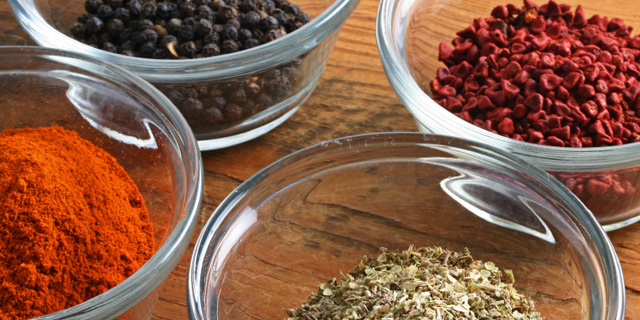Spicy is often the first word that comes to mind when describing Latin cuisine – though it’s worth noting it does not always translate to hot. Throughout Latin America and the Caribbean, dried herbs and seeds impart delicate nuances and depths of flavor to soups, stews, pastes and marinades. Traditional cooks instinctually add a little of this and that as they work, unsure of exact measurements but always confident of where they are heading. Here are a few key spices and herbs used for savory dishes that are good to have on hand when you start experimenting.
Annatto or Achiote
These burnt-orange seeds from the tropical bixa orellana bush add both color and earthy flavor to chicken, pork, and fish dishes. To make the annatto flavored cooking oil popular in the Caribbean, simply simmer the whole seeds in oil or lard until it is infused with color, then strain. The seeds can also be ground into a paste with other spices like cloves, cumin, allspice, oregano, coriander, and citrus juices to make the recado rojo famously used in Yucatecen pibil dishes among others.
Bay Leaves or Hoja de Laurel
Bay leaves hold their ground in the spice rack, imparting bright floral notes to hearty soups and stews. California varieties are stronger, but Turkish bay leaves are prized for their subtlety. Though pretty enough when floating in a simmering pot of beans, they can cause digestive problems if consumed. For added flavor, roughly crush the leaves then wrap them up in muslin or cheese cloth for easy removal before serving.
Next, three more spices essential to any Latin meal… [pagebreak]
Cumin or Comino
With roots stretching back to antiquity, including a biblical reference or two, cumin is an essential add-in for sautés, stews, and roasts. Warm and pungent with a peppery finish, it should be used sparingly to not over power the dish. For the freshest results, the golden brown seeds should be purchased whole then ground or mashed in a mortar and pestle as needed. Caraway seeds, similarly related to the parsley family, can be substituted but the amounts will vary.
Mexican Oregano or Orégano Mexicano
Mexican oregano’s high oil content gives it a special potency that pairs well with cumin. When added at the beginning of a slow simmer, the flavors have a chance to fully develop. Sold in small bags of tiny whole leaves still on the branch, it’s easily spotted in the Latin American and Mexican ingredient sections of larger chain grocery stores. Not only is Mexican oregano stronger than the Mediterranean oregano commonly available, it’s a different plant altogether.
Smoked Paprika or Pimentón
Though pimentón is closely associated with Spanish cuisine – think spice filled chorizo, golden paella, and speckled patatas bravas – the origins of this smoky red spice can be traced back to the peppers Columbus first brought back from New World. Principally grown in the Extramadura region of Spain, the red chili peppers are harvested in the fall, dried over oak wood, then ground to a fine powder. Available in dulce (sweet), agridulce (bittersweet), and picante (hot), it’s still part of a shared culinary heritage, adding a jolt to Chilean porotos granados or color to Peruvian pollo a la brasa.


![Making Mealtime Matter with La Familia: Easy Sofrito [Video]](https://thelatinkitchen.com/wp-content/uploads/2015/10/sofrito-shutterstock__0-500x383.jpg)
![Easy Latin Smoothies: Goji Berry Smoothie [Video]](https://thelatinkitchen.com/wp-content/uploads/2015/12/goji_berry-shutterstock_-500x383.jpg)
















![Fun and Fast Recipes: Fiesta Cabbage Salad [Video]](https://thelatinkitchen.com/wp-content/uploads/2015/11/fiesta_cabbage_slaw-shutterstock_-500x383.jpg)









